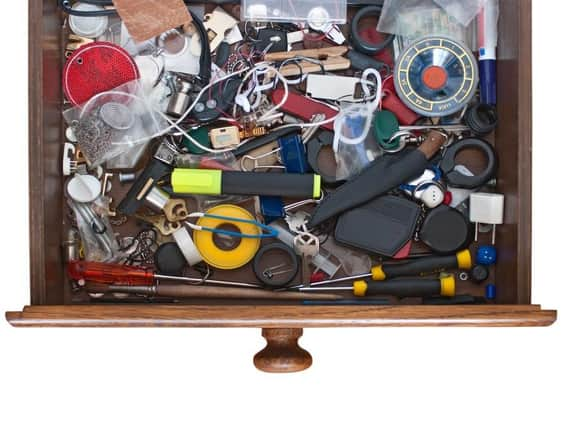LESS IS MORE: Seven out of ten Brits feel stressed by household clutter


Hygge was a huge hit last year, with its focus on comfort and relaxation, but a new study has revealed that a more minimalist approach to interiors can lead to better sleep, less stress and higher levels of productivity in the home and workplace.
A poll of 1,008 UK respondents, by self-storage company Space Station, looked into the impact of interior styles on wellbeing.
Advertisement
Hide AdAdvertisement
Hide AdAlmost two thirds (62%) of people hold onto household items that they don’t need, with the average Brit having 71 unused possessions in their home – despite the fact that seven out of ten people (70%) feel stressed by clutter.
Over half (55%) feel they sleep better and over two thirds say they are more productive (67%) when they take a minimalist approach and are surrounded by less “stuff”.
The room that most (47%) would give the minimalist treatment is the master bedroom, followed by the living room (38%) – not surprising given their association with relaxing at home. Thirty-seven per cent of people would keep their bathroom simple, while just 16% would go for the minimalist look in their child’s bedroom or study.
To help Brits to de-clutter and take a more minimalist approach to their home or office interiors, Space Station has teamed up with four leading interiors experts who have shared their advice on how to embrace minimalism:
Invest in good storage
Advertisement
Hide AdAdvertisement
Hide AdAnna Ward, interior designer at Furnished By Anna, believes that efficient storage is a good compromise when it comes to living a minimalist lifestyle. She says: “De-cluttering doesn’t have to mean getting rid of everything and living in a sterile environment! Being clever about mixing things on show with things out of sight is key, and utilising good storage makes this possible.
“Put away items that aren’t used daily or regularly, and be realistic about the things you need to keep. My rule is that if you haven’t missed these items in six months, you’ll never miss them!”
This sentiment is echoed by Judith Harrop of Judith Harrop Interior Design. She says: “When things have a home we are more likely to put them away. Keep surfaces clear and find homes for things that tend to accumulate, like household bills, bank statements and school letters. For remaining items, ask yourself “does that need to be on show?” and “does it really have a use?” If either answer is no, throw it away or find somewhere to tuck it away out of sight.”
Keep it simple
When a room is filled with oversized furniture, it can feel cramped and claustrophobic. Jess Clark, in-house interior designer at Unique Home Stays, says that you should limit your furniture to key pieces: “Choose a few interior items with clean lines and solid colours. Except for the furniture, keep floors completely clear, with nothing stacked or stored on the floor or surfaces. It’s important to avoid complex patterns or visual clutter – instead opt for classic minimalist white or earth tones in blue, brown and green, and keep walls clear aside from one or two simple pieces of artwork.”
Advertisement
Hide AdAdvertisement
Hide AdAnnie Brown, Director and Interior Specialist, says simplicity doesn’t have to mean sacrifice. “My advice when simplifying any room is to look at your furniture first, but remember, minimalism doesn’t mean sacrificing comfort. Try to stick to subdued plain colours for your main pieces of furniture, such as your sofa. Once you’ve chosen these, start to look at smaller items and keep only the essential items.”
Make it interesting
Minimalism doesn’t have to be boring, as Judith Harrop explains: “Too many styles, shapes and colours can create over stimulation. Instead, use layered textures in surface finishes such as walls, soft furnishings and flooring, rather than a bold pattern.
“Repetition works well. Think of the ‘things in threes’ rule when looking at the colour, shapes and decorative elements of your room, to create a feeling of order and harmony.”
Go digital
With new technology coming to market every day, it’s easier than ever to digitise items that take up too much space in the home.
Advertisement
Hide AdAdvertisement
Hide AdAnna Ward continued: “There are so many distractions in modern life, so it’s essential to have spaces that help and promote working. Less items on view can help greatly with productivity as a huge pile of papers doesn’t look like an easy task and can be quite off putting.
“Get technical and make the most of the cloud to store documents, pictures, films and video, and create an online to do list rather than a paper one. This allows you to check your tasks when you are out and about, and stops paper sitting around the house, which can easily distract you from the task in hand.”